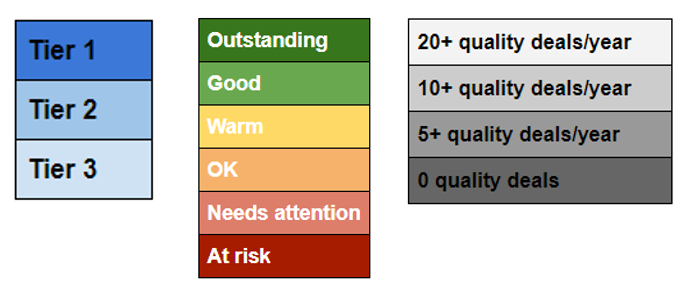CRM systems serve private equity and investment banking firms of all shapes and sizes by helping them better navigate and organize their various business development efforts and initiatives.
One CRM strategy that we see being used increasingly by deal professionals is relationship categorization, or “tiering.” This CRM contact management strategy has proven to be successful because it quickly describes the relationship with another contact or firm, and it helps teams to more quickly grasp the overall value (or potential value) that entity has. Since each firm and each investment mandate is unique, however, there is no “one size fits all” approach that can be applied.
In this article, we review the top three considerations for firms looking to roll out, or update, a categorization strategy in their CRM.
1. Select a category range that’s appropriate for your firm
While it may be tempting to choose “A,” “B,” and “C” as your categorization, our recommendation is to go through an exercise with your team (and with the help of your CRM account manager, if desired) in which you discuss the key factors to consider in creating the categorization. As seen below, you’ll notice there’s several ways to approach this process.

For some firms, the most important factor is the relationship that the firm has with its counterpart. If it’s a new relationship, assigning “Tier 3” would make sense, just as long-standing, valuable relationships should receive a “Tier 1” assignment.
If your firm is more focused on the volume and frequency of communication, and less on the history of the relationship, you may consider assigning “health” scores. In this scenario, for example, an entity that hasn’t been contacted by the firm in over 3 months would receive an “at risk” assignment, and an entity who has been in touch with the firm in the last week would receive an “outstanding” assignment.
There are also certain private equity firms who assign categories based on the quantity and quality of deals received from investment bankers each year. We recommend this strategy only in situations where the firm has a clear definition of “quality deals” and can use the numerical benchmarks as part of their quarterly/annual business development goal setting exercise(s).
As you can see, there are many factors to consider in creating a categorization system for your CRM. If you’re creating something new, we recommend asking the following questions to your team to get started:
- What measures are most important to us?
- How can we use this categorization to guide our business development activities?
- Are there any outliers? (i.e., consider if there are any situations of entities that would fall outside a categorization system you’re creating)
2. Create a system with a 5-year shelf life
As your firm grows and evolves over time, so should your CRM system. When creating or re-vamping your categorization system, it’s important to consider how the needs of the firm will change, and what will remain the same.
While it’s impossible to predict the future, we recommend instituting a CRM contact management system that will last your firm for at least 5 years. For most firms, that timeline will survive the lifecycle of a fund. Additionally, that timeline will mean less administrative and duplicative work your teams will have to perform.
3. Get the necessary buy-in
As with all technology enhancements and implementations, it’s important that the decision-makers leading the process get buy-in from the team firm-wide. This may require decision makers to shadow power users to better understand how they use categories to guide their workflows day-to-day, or gather tips and tricks from other firms who have a particular categorization strategy that they like.
No matter what approach your firm lands on, it’s critical to get it right the first time. With the consideration of your team in mind, combined with a smart and nimble CRM technology in hand, and the support of implementation experts, your team should be up and running with its new or improved categorization system in no time!
Not sure where to start? Get in touch with us! We have plenty more categorization tips and tricks to share.
